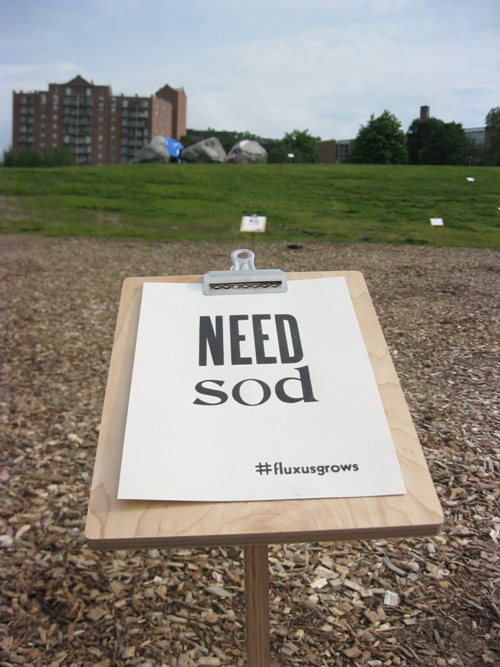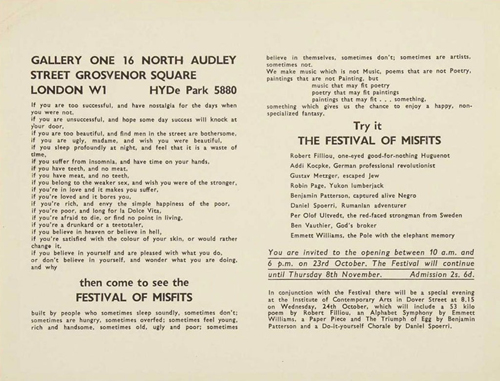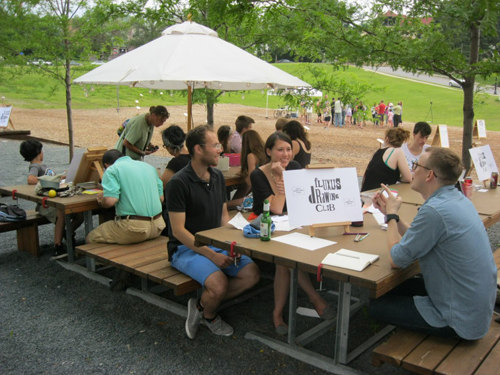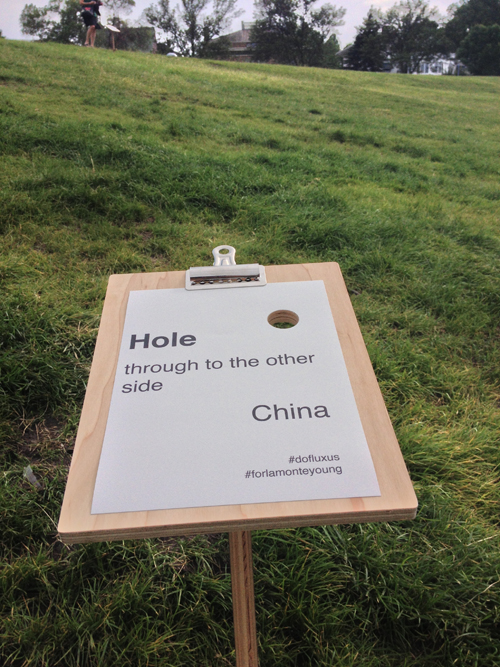[originally posted on the Walker’s Field Lab blog]
This past summer Sarah Schultz and the Open Field team invited me to come to the Walker and consider the movement Fluxus. This research-based residency encompassed three projects: transforming the Star Tribune Foundation Art Lab into a visitor and residency space; creating a mobile cart for use in the Minneapolis Sculpture Garden; a series of Fluxus-based projects that I developed for Open Field, including an installation known as FluxField Interpretive Trail.
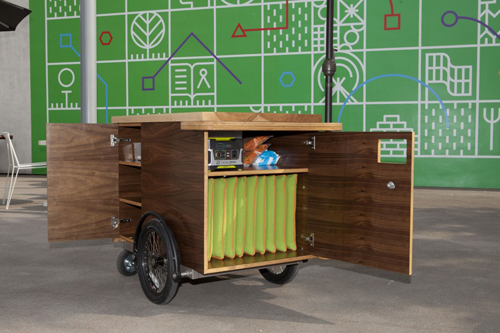
Open Field Cart, developed for staff and visiting artists, photo by Gene Pittman. Fabrication design by Pseudo Studio.
Living the Life of the Idea
“Living the life of the idea” was an expression that Sarah put forth as a sort of central challenge as I approached Fluxus. I soon learned that it was not something that came easily; Fluxus led me down several rabbit holes.
I am a San Francisco-based museum exhibit designer with an affinity for social practice. When I work on projects, I take the deep dive into the world of the place, space, or community until I can comfortably swim around with it. Often my work with museums involves engaging arts movements through the lens of the originating historical moment. Fluxus, however, is about a series of moments amongst a distributed group of artists that don’t necessarily agree on what the movement is, so it got messy fast.
Since Fluxus artists never seem to agree on anything, Fluxus has become “a pain in art’s ass” in the words of Fluxus artist Ben Vautier.
–Hannah Higgins, Fluxus Experience
Considering an Art Movement is an Endeavor Best Shared
Before coming to Minneapolis, Chris Kallmyer (another San Francisco-based FluxField artist) and I met a few times a month to prepare for our residencies. He would explore ideas and approaches around working with (or through) Fluxus, and I wrestled with how to engage with an amorphous movement through my practice. We took a stab at writing a Manifesto for Field Lab Residencies, which seemed to fit with Fluxus philosophies. This manifesto reinforced the first rule of residency: a freedom from externally imposed constraints—especially the traditional constraints of museum exhibition development.
In anticipation of the summer, Chris and I came to the Walker for a week in March. A group of local artists were invited to learn more about the work we were doing, and to think about FluxField projects of their own. We had freeform conversations around Fluxus philosophies and possibilities for our work. It was evident that choosing these artists was an act of curation and subtle matching-making on Sarah Schultz’s behalf. Three of them, Mike Haeg, Margaret Pezalla-Granlund and Jenni Undis, became collaborators on my summer projects.
Access is a museum’s jewel, and our group was invited to intimately examine the Walker’s Fluxus collection while talking with Registrar Dave Bartley. Viewing this material oriented me towards the historic, intellectual and social craft of Fluxus. It’s ironic to think that a movement so ephemeral could inspire with its bits of paper and odd performances.
I’m a Misfit and so are We
At the Walker Library I came across reviews and articles about the “Festival of Misfits.” It was billed as an event “…by people who sometimes… are artists, sometimes not… we make music… that may fit poetry, poetry that may fit paintings, paintings that may fit… something.” Much of that content was formative for my work. In their humor and rigor, I began to see a trajectory from Fluxus towards experimental museum projects and social practice. My prior work in the experimental realm has included the Giant Hand at the Hammer Museum, and the Big Table Gallery at the Baltimore Museum of Art. The Giant Hand pushed against the framework of the museum experience, and the Big Table pushed against ways to convey a concept in contemporary art (vs. a work of art) to the public.
This type of project is often difficult, working against traditional definitions of a museum and how it operates. But this is where the innovations and interesting questions lie. Like these previous projects, Fluxus was able to collectively play in the space of uncertainty.
Scores for People Who Don’t Know How to Write Scores
Sarah encouraged me to use event scores as a central part of my endeavors so I wanted to have a suite of experiences rather than a singular one. This seemed truer to Fluxus and left room for differences in subjectivity and different types of visitors.
As I researched, I kept coming back to this notion that Fluxus artists were making art out of noticing everyday moments and realized how ridiculous they would think things are today: we notice and share everything. Regardless, I’m old enough to know the world before cheap electronics and Ikea. Moments lasted beyond a tweet and were often reflective and quiet in nature, if not sound. Fluxus was where these artists began to share moments, through scores written, mailed, reinterpreted and performed around the globe.
Finding a Path
The pieces of my projects for Open Field came together organically. Drawing Club, a collaborative and participatory drawing event, was already a weekly Open Field program, and I decided to create a Fluxus Drawing Club. I worked on this in collaboration with Margaret Pezalla-Granlund, one of the local FluxField artists, who seemed to share an affinity with Fluxus in both concept and craft. Together we wrote, shared, edited and designed scores, making and distributing a series of Flux Kits with light instructions printed inside. I also asked Margaret and her family to make a recording of Dick Higgins’ book A Child’s History of Fluxus, as background for the evening of projects. You can listen to it here.
While planning this Open Field programming, I realized that displaying artifacts or defining Fluxus for the public wasn’t possible or appropriate: Fluxus is a constellation of orchestrated moments and experiences, and a way of thinking. But wandering in a field, just like Fluxus Drawing Club, is experiential. It fit my intentions by allowing the public to participate in Fluxus in a low-stakes way.
For me, Open Field + Fluxus = FluxField Interpretive Trail.
I generated scores that were letter pressed by local printmaker Jenni Undis to capture the Fluxus philosophy of art that was “neither an exhibition of objects or a performance, but somewhere in between.” (George Brecht, Wikipedia). My scores included commentary on Fluxus (“The most ambiguous club in the art world”), quotes from founding Fluxus artists, and field observations (“Need Sod”). Humorous #hashtags became an organizing principle of the trail, helping the public understand if the scores were foundational, descriptive, or invitational.
On the culminating evening of my residency, scores were installed on low stakes and throughout the field. Members of the public wandered along the giant trail of scores, beer in hand, taking a picture or two. A giant poodle took off with the balls stationed next to the Play Ball score. Artist Mike Haeg’s Penny Event was incorporated around the edges of the field adjacent to the trail, which caused delight and confusion. At Fluxus Drawing Club, participants sat and worked at length on their score drawings and children happily stamped “Official Fluxus Approved Score” all over their papers. In the end, the question “what is Fluxus?” was best answered by the experience of Fluxus.
Go Where the Interesting Problems Are
Throughout my residency, my driving question changed from ‘what are participatory strategies for the public to engage with an art movement?’ to ‘what can ‘living the life of the idea’ look like as we create museum experiences?’ How can we answer questions together? Who is included in ‘together’? I hope that the museum field can make space to support posing and playing with these formative questions. Open Field was a powerful incubator. I want to expand on ways of thinking about interpretive experiences, creating new tools that are intelligent, nuanced and in synch with the artworks or movements, as well as the contemporary public.
Hannah Higgins, the daughter of founding Fluxus members Dick Higgins and Alison Knowles, described Fluxus as having an “elasticity of its social formation.” It is precisely that elasticity which made it possible for us to interpret, create, and disseminate along the way. It became a perfect umbrella, full of holes and sunshine.

